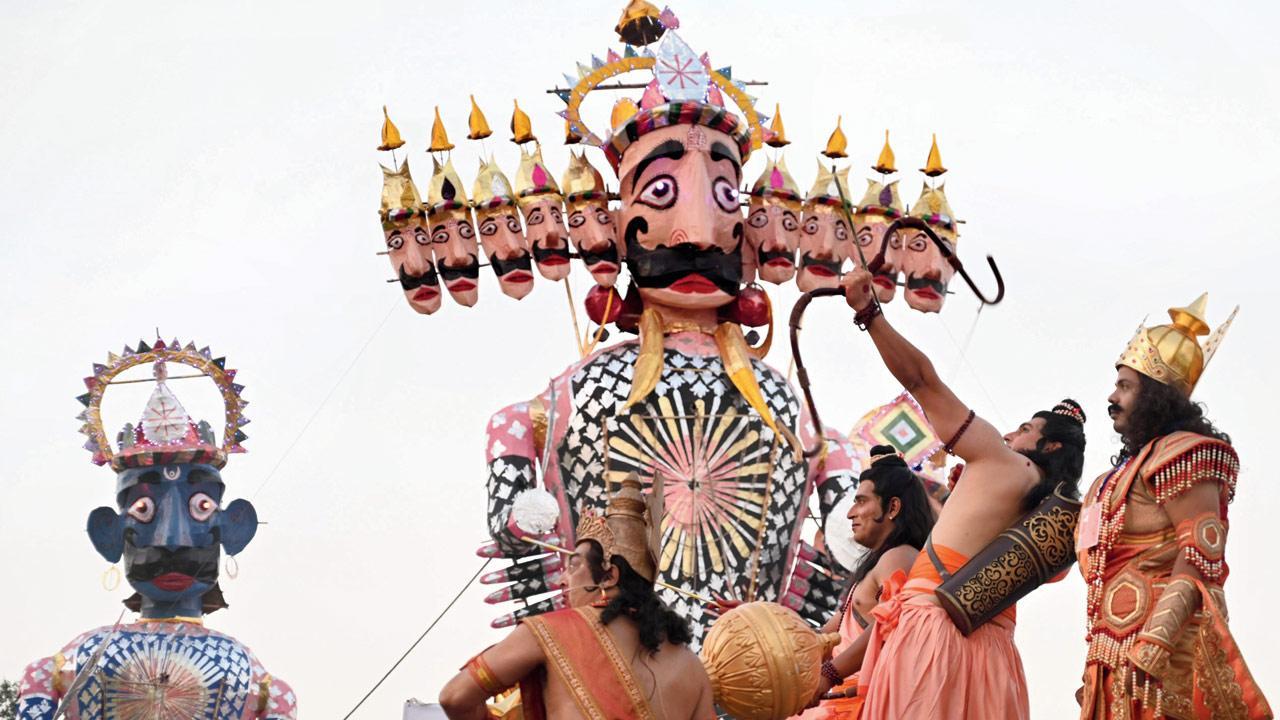....and many more versions of Ramayana are what we suggest you read this Diwali. Delve into how communities across India find comfort and inspiration in their own version of the timeless epic

The effigies of Ravana, along with Kumbhkaran and Meghnath, burn during Dussehra celebrations by Shri Dharmic Leela Committee Madhav Das Park, Red Fort Ground in October. Pics/Getty Images
The Ramayana, one of India’s most revered epics, has travelled through time, constantly reinterpreted by different communities and storytellers. Each retelling adds a new dimension, offering insights into the characters’ journeys while reflecting the evolving moral and cultural fabric of Indian society.
ADVERTISEMENT

Artists perform Bharatanatyam to portray Jatayu Moksham, a story from Ramayana at the Kalakshetra Foundation in Chennai in February, 2024
While the core story of Ram remains constant, the lens through which we perceive it continues to shift. From folk ballads in rural India to modern feminist versions, the Ramayana remains a living text, evolving alongside society. This Diwali, as we celebrate the triumph of light over darkness, we can reflect on the many ways communities have found their own meanings in the story of Ram and Sita.
Finding a connect with nature
One of the latest retellings of the epic is Vayu Naidu’s “The Living Legend”, which launched just this Dussehra. It offers a fresh perspective on the epic through an eco-conscious lens, blending mythology with modern environmental themes. “The themes of climate change are integrated in the story as nature is a central character” says Naidu. Set in the Dandaka Forest, Naidu’s version places nature at the heart of the story. “The forests do take on a central and pivotal role,” Naidu explains, noting that Valmiki, who lived in the wild, inspired the epic’s origins. Rama’s first encounter with the decayed Dandaka forest became, for Naidu, “an expression of what we experience today with toxic waste in rivers, deforestation…the balance of nature is an imperative.”

Vayu Naidu
“The underlying story about love and reconciliation with all beings, while knowing what it means to fight for justice. It is the principal driving force that took the epic on its South East Asian voyage” she says. Naidu’s approach to her retelling of the epic connects ancient myths with today’s ecological concerns. “If nature is ruined, so is all of what we construct as human civilisation,” she says, highlighting the story’s universal resonance. “For me, Ramayana is about self reflection” says Naidu “when I went as an Arts practitioner to Her Majesty’s Prison, one inmate heard me telling the story of Valmiki before he became a legend and wept, saying, ‘Even criminals can write poetry!’” Naidu hopes her novel speaks to readers about climate change: “It’s the mythology of our living time.”
Sita as the true heroine

Chandrabati’s ‘Sitayan’. Pic/sarahholz.com
Another powerful reinterpretation of the epic comes from Chandrabati, a 16th-century Bengali poet whose work, often called Sitayana, shifts the focus from Ram to Sita. Translated into English by Nabaneeta Dev Sen in 2020, this version presents Sita as the true protagonist. Chandrabati’s Ramayana is a deeply personal one, beginning with a retelling of Sita’s birth and focusing on her struggles, including her exile and her eventual return to Mother Earth. Unlike traditional versions that highlight Ram’s battles, Chandrabati’s work centres on Sita’s emotional journey, offering a feminist reimagining of the epic.
As the first female author to write a retelling of the Ramayana, Chandrabati’s ‘Sitayana’ brings Sita out of the margins and into the spotlight, challenging traditional gender roles and elevating her inner life in a way that resonates deeply with contemporary readers.
Kaikeyi ki kahaani
Kaikeyi: The Mother of a God revisits the much-maligned queen of the Ramayana, offering a more sympathetic portrayal of her character. The novel opens with a dramatic trial where Kaikeyi defends herself against accusations of high treason, reflecting on her political manoeuvring and personal motivations. Through flashbacks, the story reveals Kaikeyi’s upbringing as a warrior princess and her strategic marriage to Dashrath.

Suresh Kala
Suresh Kala’s portrayal of Kaikeyi transforms her from a villain into a complex and even morally grey figure driven by love for her son and the weight of royal responsibilities. The novel redefines Kaikeyi’s role, emphasising her strength, wisdom, and sacrifices.
Each of these retellings adds new layers to the Ramayana, reflecting the concerns of their time while challenging readers to look beyond the traditional narrative. Whether through an eco-conscious lens, a feminist perspective, or an alternative viewpoint from the “villains,” these stories remind us that the Ramayana continues to evolve as we do.
Have a laugh

Dr MN Karassery
The Mappila Ramayana, as explored in Chapter 19 of Ramayana Stories in Modern South India, offers a unique retelling from Kerala’s Mappila Muslim community. Collected and transcribed by MN Karassery, this version is known for its humorous and eccentric take on the epic, merging Islamic and Hindu elements. Sung by the performer Hassankutty, this retelling uses Mappila ballad meters, blending cultural elements from both traditions. Characters like “Lama” for Rama and “Lavana” for Ravana highlight this blend, reflecting a period of peaceful coexistence between Hindu and Muslim communities.
This version adds a witty, multicultural flavour to the Ramayana, showing how oral traditions can reshape and recontextualise India’s beloved epic.
Ravana had his own version

Anand Neelakantan
This retelling offers a completely different perspective on the Ramayana by telling the story from Ravana’s point of view. This retelling humanises Ravana, portraying him as a flawed yet ambitious leader who sought to uplift the Asuras. Through Ravana’s narrative, Anand Neelakantan challenges the traditional glorification of Ram, exploring themes of rebellion, justice, and the complexities of morality. By presenting Ravana’s internal conflict between love, pride, and ambition, Neelakantan’s work invites readers to reconsider the traditional lines between good and evil.
 Subscribe today by clicking the link and stay updated with the latest news!" Click here!
Subscribe today by clicking the link and stay updated with the latest news!" Click here!







